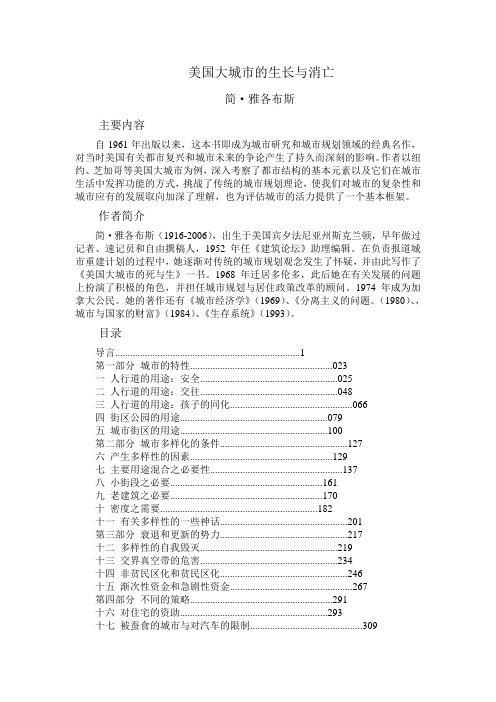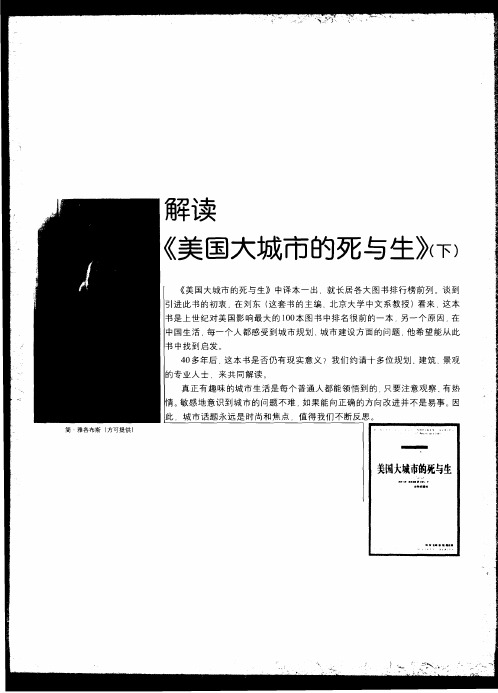美国大城市的生与死(中英)
- 格式:doc
- 大小:267.00 KB
- 文档页数:60

美国大城市的死与生
佚名
【期刊名称】《商业价值》
【年(卷),期】2012(000)006
【摘要】简·雅各布斯的《美国大城市的死与生》,被人视为是关于城市规划的最具影响力的著作。
她用独到的视角和心灵,对现有的城市规划观念进行了有力的抨击。
书中关于街道、老建筑、廉租屋和交通的精彩论述,相信会带给那些现在栖身于大城市的中国读者强烈的启发和震撼。
下面是书中一些精彩的片段:
【总页数】1页(P128-128)
【正文语种】中文
【中图分类】F832.48
【相关文献】
1.《美国大城市的死与生》对我国城市发展启示研究
2.当下中国需要怎样的城市--再读《美国大城市的死与生》有感
3.关于城市街区人行道功能的认识--读《美国大城市的死与生》有感
4.《美国大城市的死与生》书评
5.《美国大城市的死与生》读后感
因版权原因,仅展示原文概要,查看原文内容请购买。

美国大城市的生长与消亡简·雅各布斯主要内容自1961年出版以来,这本书即成为城市研究和城市规划领域的经典名作,对当时美国有关都市复兴和城市未来的争论产生了持久而深刻的影响。
作者以纽约、芝加哥等美国大城市为例,深入考察了都市结构的基本元素以及它们在城市生活中发挥功能的方式,挑战了传统的城市规划理论,使我们对城市的复杂性和城市应有的发展取向加深了理解,也为评估城市的活力提供了一个基本框架。
作者简介简·雅各布斯(1916-2006),出生于美国宾夕法尼亚州斯克兰顿,早年做过记者、速记员和自由撰稿人,1952年任《建筑论坛》助理编辑。
在负责报道城市重建计划的过程中,她逐渐对传统的城市规划观念发生了怀疑,并由此写作了《美国大城市的死与生》一书。
1968年迁居多伦多,此后她在有关发展的问题上扮演了积极的角色,并担任城市规划与居住政策改革的顾问。
1974年成为加拿大公民。
她的著作还有《城市经济学》(1969)、《分离主义的问题。
(1980)、,城市与国家的财富》(1984)、《生存系统》(1993)。
目录导言 (1)第一部分城市的特性 (023)一人行道的用途:安全 (025)二人行道的用途:交往 (048)三人行道的用途:孩子的同化 (066)四街区公园的用途 (079)五城市街区的用途 (100)第二部分城市多样化的条件 (127)六产生多样性的因素 (129)七主要用途混合之必要性 (137)八小街段之必要 (161)九老建筑之必要 (170)十密度之需要 (182)十一有关多样性的一些神话 (201)第三部分衰退和更新的势力 (217)十二多样性的自我毁灭 (219)十三交界真空带的危害 (234)十四非贫民区化和贫民区化 (246)十五渐次性资金和急剧性资金 (267)第四部分不同的策略 (291)十六对住宅的资助 (293)十七被蚕食的城市与对汽车的限制 (309)十八视觉秩序:局限性和可能性 (341)十九拯救和利用廉租住宅区 (360)二十地区管理和规划 (372)二十一城市的问题所在 (393)致谢 (412)索引 (414)。



美国大城市的死与生暑假读了一本名为《美国大城市的生与死》的书,作者简·雅各布斯凭着超群的敏锐观察力和一份对城市生活的执着热爱,写出了这本城市建筑学的恒久经典之作,据了解,这本书自出版即成为了城市研究和城市规划领域的经典名作,并对当时美国有关都市复兴和城市未来的争论产生了持久深刻的影响。
作者分了四个部分阐述,分别是城市的特性、城市多样化的条件、衰退和更新的势力和不同的策略。
在书中,作者雅各布斯以纽约、芝加哥等美国大城市为例,以流畅而充满激情的文字,深入考察了都市结构的基本元素以及它们在城市生活重发挥功能的方式。
势什么使得街道变得安全或不安全?为什么有些城市花园赏心悦目,有些却是藏污纳垢之地和四忙陷阱?是什么构成街区,它在更大的城市机体中发挥什么样的作用?为什么有些街区仍然贫困,有些街区却获得新生?等等。
通过对这些问题的回答,雅各布斯对城市的复杂性和城市应有的`发展取向加深了理解,也为评估城市的活力提供了一个基本框架,更使我们读者有受益匪浅,豁然开朗。
然而她并不是用严谨枯萎的语言和无味的陈述去抒发她的独到见解而是讨厌精妙地将人与人的活动及活动场所交织出来,展现在我面前的就是出来一幅丰富多彩的城市生活画面。
在雅各布斯的眼中,城市就像是人体一样在运作,街道就是大大小小的动脉和血管,每一条都存有自己特定的功用,而定期的重修能够并使它们充满活力。
她的城市理念就是:人口必须低密集涌入,因为密度意味著安全;城市不必须分区,这样人们可以在工作的地点附近定居;人行道一定必须足够多宽大,使孩子民主自由嬉戏在其中;街道必须短小,使行人每每产生拐弯的新鲜感。
在书中,她倡导将人口和各种活动涌入出来,共同共同组成一幕忧伤自在的城市生活:她提倡城市“多中心化”,特别强调必须珍视城市长期以来构成的多元性和混合性,这不但贴近了对环境培养了依赖性的人的心理。
她的文字也充满了说服力。
在书中,我们可以感觉到,一切都是从城市生活的直感出发的,作者分析的起点是最细微之处,是最微观的城市城市元素,阅读中常常感受到她那生活化的思想风格,锋芒深隐在对城市的病症的搜寻中。

读书笔记——读《美国大城市的死与生》第一篇:读书笔记——读《美国大城市的死与生》读书笔记——读《美国大城市的死与生》【摘要】:本文为看规划界的著作《美国大城市的死与生》一书后的读书心得。
文章对《美国大城市的死与生》的写作背景、作者简.雅各布斯的情况进行了简单综述;进而对书本中4个部分的主要内容及观点进行了解读;此外,描述了此书对笔者所产生的一些启示及思考,并用书中的方法分析了笔者曾经生活了五年的城市——广州的一些典型公共空间。
1.《美国大城市的死与生》的写作背景1961年,简.雅各布斯出版了她的名著《美国大城市的死与生》(The Death and Life of Great American Cities)。
这本书产生的时代背景,可以追溯到第二次世界大战后西方工业化国家开始出现的人口生育高峰,并由此带来的一系列对基础设施和社会服务的需求。
就美国而言,城镇化进程继续加快,大都会地区进一步形成,原有的、以开发建设为主体的综合规划体系及其理论在新的需求冲击下不知所措。
伴随着郊区的发展,美国大城市普遍出现了城市中心区衰败的现象。
面对“规划师们”采用传统现代城市规划和重建改造正统理论的原则来解决城市更新和改造的问题,作者站在一个普通公众或社会工作者的立场,通过自己的观察与思考,对现代城市规划和城市建设进行了猛烈的抨击,并提出了一些基于社会和经济考虑的城市规划思想。
2.作者简介本书作者:简.雅各布斯Jacobs, Jane(1916-2006)简·雅各布斯1916年生于美国宾夕法尼亚州一个小镇斯克兰顿,她家族中几代女子都与男性一样拥有职业,而且大多数是教师。
在她的家庭中女孩和男孩被同等对待,家族的这一传统塑造了她果敢而特立独行的性格。
中学毕业后雅各布斯不愿去上大学,在接受了一段时间的速记员培训后,她却去了当地的一家报纸《斯克兰顿论坛》做义务记者。
经济大萧条时期她去了纽约,为时尚杂志《Vogue》撰稿。
《美国大城市的死与生》
钟广丽
【期刊名称】《建筑技艺》
【年(卷),期】2006(141)006
【摘要】《美国大城市的死与生》不只是一本探讨现代城镇规划的书,这是一本
关于城市——城市的生命、城市的经济的书。
这本书自1961年出版以来.就成
为城市研究和城市规划领域的经典名作。
在书中,简·雅各布斯并非从专业规划师
的角度,而是以一个普通市民的角度,用眼睛,用直觉,用心灵观察她所在的城市,并提出一些问题:什么使得街道安全或不安全,什么样的城市才是充满活力的,什么使得城市的多样性面临自我毁灭.为什么有的街区仍然贫困而有些却获得新生与活力?这些问题确实足以令踌躇满志的现代城市的规划师发以深省。
【总页数】1页(P32)
【作者】钟广丽
【作者单位】无
【正文语种】中文
【中图分类】TU984
【相关文献】
1.《美国大城市的死与生》对我国城市发展启示研究 [J], 梁敏
2.当下中国需要怎样的城市--再读《美国大城市的死与生》有感 [J], 朱凯;隆垚;王嘉
3.关于城市街区人行道功能的认识--读《美国大城市的死与生》有感 [J], 易秋丽;许可
4.《美国大城市的死与生》书评 [J], 黄江松
5.《美国大城市的死与生》读后感 [J], 毛彦琪
因版权原因,仅展示原文概要,查看原文内容请购买。
美国大城市的生与死第一部分城市的特性·人行道的用途:安全、交往、孩子的同化·一条城市街道想要应付陌生人,在陌生人多的时候确保安全,必须具备三个条件:1. 在公共空间与私人空间之间必须要界限分明2. 必须要有一些眼睛盯着街道3. 人行道上必须要有行人一个被成年人监视的街道才是安全的,在街道上的每一个人都是安全的保障。
因为安全,街道可能会吸引更多的人来交流,由此进入一个良性循环。
第二部分城市多样化的条件·城市的街道和地区发生多样性的四个条件(缺一不可):1. 主要功能必须多于一个(最好两个)2. 街道必须要短3. 建筑物多样(包括适当比例老建筑且混合均匀)4. 一定量的人流◇首要用途混合之必要性:1. 一种首要用途,不管它是什么,如果只是发挥其单一的作用,那从创立城市多样性的角度来说,它的作用是无效的。
2. 如果它与另一种首要用途结合在一起,但只是在同一时间里,把人群引入和引出一个地方,那它还是什么目的也没有达到。
3.只有当一个首要用途与另一个能够在不同的时间里把人群吸引到街上来的首要用途相结合在一起时,他们产生效应才具备了刺激经济的作用:为第二种多样性的发挥准备了肥沃的土壤。
首要用途的混合能够达到使地区使用时段平衡的目的,能有效避免高峰时拥挤,低峰时闲置的情况。
·第二中多样性是指那些为回应第一种用途二发展起来的商业(商店和服务设施),主要是服务于被首要用途吸引来的人群。
如果这第二类多样性只单一地服务于首要用途,那么不管是什么形式的用途,注定是无效的。
如果想要产生内在的有效的作用,那就要服务于多个混合的首要用途。
(如果其他的三个繁盛多样性的条件也被充分注意的话,那么这种有效性则会使惊人的。
)良好的商业环境需要不同时间段的不同人群的持续交叉使用来支撑。
如果只是短时间的大量人流虽然也会带来可观的经济效益,但是在资源的合理配置和商业的长久发展来看都是不利的。
这就好比是某一路段高峰时及其拥堵,低峰时完全闲置,这种情况下的道路通行量远远不如时时保持畅通状态下的道路通行量大。
《美国大城市的生与死》读书报告专业:建筑设计及其理论姓名:学号:指导老师:书名:《美国大城市的生与死》作者:简·雅各布(JaneJacobs)出版日期:1961年读书时间:一周规划建设的回顾与反思摘要:《美国大城市的死与生》中对现代主义城市规划理论的批判和提出的的某些新城市规划原则现在早已经变成建筑师、规划师们普遍接受的基本认识,但是,这本书毕竟写成40多年了,雅各布斯书中的不足也逐渐显现出来。
她没有探讨大型企业对城市生活的影响,她忽略了营建小而复杂的社区必将给基础设施建设带来的压力,等等。
她书中所渗透的人文精神和自下而上的民主意识仍打动着很多人,是她带来的影响最终憾动了那些高高在上的专业人士,使他们看到普通居民的生活应该这么丰富,一个城市,本可以更好。
关键词:实际效用、邻里关系、安全、人文继承,导言:中国现在的城市规划,正在走西方五六十年代的老路。
原来,美国的规划师也曾经那么主观,1959年,作者(简·雅各布斯)给一位波士顿规划者打电话时,他告诉作者,“北端”是一个恐怖的贫民区,需要改造,人们必须离开。
但作者看到的,却是“勾嵌得整齐的砖墙,新的百叶帘”,并被“活泼、友好和健康的气氛”感染。
事实上,数据表明,“北端”的少年犯罪、疾病和婴儿死亡率都最低,还是按收入计算租费最低的地方。
在这里,对世界的描述来源于专家的主观,即它应该是什么样子的,而不是它实际上是什么样子的。
但正确的描述,却应该与之相反。
正如一位纽约东哈莱姆的居民说的,那些大人物跑来看到绿草坪,说,多美妙啊,现在穷人也有这一切了。
事实却是,“他们推倒了我们的房子,将我们赶到这里,把我们的朋友赶到别的地方。
在这儿我们没有一个喝咖啡或看报纸或借五美分的地方。
没有人关心我们需要什么”。
是的,很多时候,行为漂亮才是漂亮(实际做的要比外表更漂亮),会闪光的并不都是金子。
而更深层次的含义是,有一种东西比公开的丑陋和混乱还要恶劣,那就是带着一副虚伪面具,假装秩序井然,其实质是视而不见或压抑正在挣扎中的并要求给予关注的真实的秩序。
1 «美国大城市的生与死» (THE DEATH AND LIFE OF GREAT AMRICAN CITIES)
美国女作家简.雅各布斯(Jane Jacobs) 1 Introduction (1) This book is and attack on city planning and rebuilding. It is also, and mostly, an attempt to introduce new principles of city planning and rebuilding, different and even opposite from those now taught in everything from schools of architecture and planning to the Sunday supplements and women’s magazines. My attack is not based on quibbles about rebuilding methods or hairsplitting about fashions in design. It is an attack, rather, on the principles and aims that have shaped modern, orthodox city planning and rebuilding.(2002.2.8) (2) In setting forth different principles, I shall mainly be writing about common, ordinary things: for instance, what kinds of city streets are safe and what kinds are not; why some city parks are marvelous and others are vice traps and death traps; why some slums stay slums and other slums regenerate themselves even against financial and official opposition; what makes downtowns shift their centers; what, if anything, is a city neighborhood, and what jobs, if any, neighborhoods in great cities do. In short, I shall be writing about how cities work in real life, because this is the only way to learn what principles of planning and what practices in rebuilding can promote social and economic vitality in cities, and what practices and principle will deaden these attributes.(2002.2.8) 译文: 介绍 (1)这是一本抨击现今城市规划和改造的书。应该说书中的大多数内容,尝试着介绍新的城市规划和改造原则,这些原则不同于学校里所传授的东西,不同于周日特刊的计划,也不同于从妇女杂志中所看到的,甚至是与那些原则完全相反的。我的抨击并不是以关于改建手法的模棱两可的双关语为基础,也不是对设计的时尚吹毛求疵。它所抨击的是那些形成现代和传统城市规划和改造的原则和目的。 (2)为了阐明这些不同的原则,我从那些普通的事物写起:例如,什么样的城市街道是安全的,而什么样的是不安全的;为什么有的城市公园是美妙的不可思议的,而有的则成为了城市藏污纳垢的死角;为什么有些贫民窟长久保持原样有些不顾财政和政府的反对不断生成;是什么让城市不断变换他们的中心;什么是一个城市的临近地区,它有担当了什么样的一种职能。简而言之,我要写的是城市在现实生活中是如何运作的,因为这是学习规划原则和怎样用改建来提升城市的社会和经济活力的唯一方法,通过这样的学习,也能知道什么样的原则和实践会扼杀这些活力。(2002.2.9 benbentiao 译) 2
(3) There is a wistful myth that if only we had enough money to spend—the figure is usually put at a hundred billion dollars—we could wipe out all our slums in ten years, reverse decay in the great, dull, gray belts that were yesterday’s and day-before-yesterday’s suburbs, anchor the wandering middle class and its wandering tax money, and perhaps even solve the traffice problem.(2002.2.9) (4) But look what we have built with the first several billions: Low-income projects that become worse centers of delinquency, vandalism and general social hopelessness than the slums they were supposed to replace. Middle-income housing projects which are truly marvels of dullness and regimentation sealed against any buoyancy or vitality of city life. Luxury housing projects that mitigate their inanity, or try to, with a vapid vulgarity. Cultural centers that are unable to support a good bookstore. Civic centers that are avoided by everyone but bums, who have fewer choices of loitering place than others. Commercial centers that are lackluster imitations of standardized suburban chain-store shopping. Promenades that go from no place to nowhere and have no promenaders. . Expressways that eviscerate great cities. This is not the rebuilding of cities. This is the sacking of cities.(2000.2.9) (3)有一种理想的“神话”,前提是我们拥有足够的资金——通常得上百亿美金——我们便可在十年内清除所有的贫困区,隐藏起从前城市中那些庞大、阴暗、沉闷地带内所呈现出的衰败景象,转而安置飘泊的中产阶级,沉淀及其附带的游离资金,这样甚至可以解决交通问题。(2002.2.10 永远的埃及 译) (4)现在看看我们用一开始的几十亿作了什么:低收入居民区变成了错误,破坏艺术行为和社会绝望的中心,代替了贫民窟给社会带来的影响。中层收入居民区的无趣和对一切轻快和有活力的城市生活的管辖让人觉得惊奇。奢华的小别墅妄图用一种粗俗的设计手法区减轻他们的愚蠢。文化中心里不能找到一个好的书店。除了流浪汉谁都不愿意去城市中心,因为那里是少数几个能供他们闲逛的场所。商业中心是标准的郊区连锁店的翻版。散步道不知位于何处,当然见不到散步的人,高速公路变成了城市的精华部分。这不是对城市的改造,这是对城市的毁坏。(2002.2.11 benbentiao 译) 3
(5) Under the surface, these accomplishments prove even poorer than their poor pretenses. They seldom aid the city areas around them, as in theory they are supposed to. These amputated areas typically develop galloping gangrene. To house people in this planned fashion, price tags are fastened on the population, and each sorted-out chunk of price-tagged populace lives in growing suspicion and tension against the surrounding city. When two or more such hostile islands are juxtaposed the result is called “a balanced neighborhood.” Monopolistic shopping centers and monumental cultural centers cloak, under the public relations hoohaw, the subtraction of commerce, and of culture too, from the intimate and casual life of cities.(2002.2.10) (6) That such wonders may be accomplished, people who get marked with the planners’ hex signs are pushed about, expropriated, and uprooted much as if they were the subjects of a conquering power. Thousands of small businesses are destroyed, and their proprietors ruined, with hardly a gesture at compensation. Whole communities are torn apart and sown to the winds, with a reaping of cynicism, resentment and despair that must be heard and seen to be believed. A group of clergymen in Chicago, appalled at the fruits of planned city rebuilding there, ask, (7) Could job have been thinking of Chicago when he wrote: (8) Here are men that alter their neighbor’s landmark…shoulder the poor aside, conspire to oppress the friendless. (5)事实上,这些整治比它们那些有够衰的pretense们更衰. 它们极少如它们的理论所臆断的那样,在自身周围增加新的城市环境.相反,这些从城市机体上截下来的部分往往发育成急性坏疽: 在时尚的"规划"指导下, 居民人口被贴上"价格"的标签, 塞进某处组团. 而每一坨甄选出来带着价标的人口,则在与周围城区日益增长的怀疑与紧张关系中生长. 如果两个以上的互含敌意的组团被搁在了一起,那么我们就得到了一个"平衡社区". 在公共关系hoohaw的张罗下, 垄断型商业中心和纪念碑样的文化中心掩饰了商业和文化的匮乏 --- 而后两者, 在随意而亲切的都市生活中,曾是如此的丰富 (2002.2.12 除夕的鞭炮响过之后 Spade 译) (6)这种奇迹或许可以实现,然而那些标上了规划师们具有蛊惑力的标志(注:猜想可能是指所住区域被规划)的人们遭排挤,家园被略夺,最终背井离乡,就像是好胜心下的战利品.成千上万的小商业被毁,它们的经营者遭损失.但几乎没有得到补偿的迹象.而整体社区被分裂,象种子般在风中撒落,带着嘲讽,怨恨和失望, 这些规划者必须看到也必须相信这些.一群惊骇于规划重建后芝加哥城市状况的牧师寻问道: